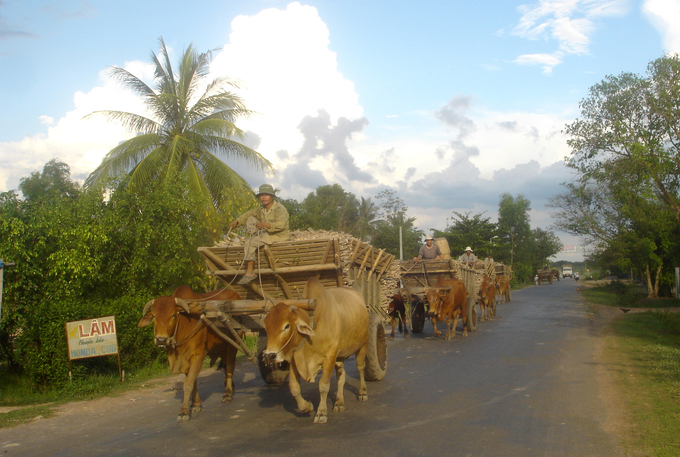November 27, 2025 | 19:57 GMT +7
November 27, 2025 | 19:57 GMT +7
Hotline: 0913.378.918
November 27, 2025 | 19:57 GMT +7
Hotline: 0913.378.918

The transportation of cassava on a rural road in Tay Ninh. Photo: Son Trang.
According to the Vietnam Cassava Association, the vast majority of cassava processing factories in Northern Vietnam have ceased operation and subsequently ended the 2022-2023 production year prematurely. The current amount of inventory in factories is not substantial, so factories with available financial resources will maintain a steady sales volume until the new crop in August 2023.
Due to the scarcity of late-crop cassava, fresh cassava prices in the Central and Central Highlands are exceptionally high. Many local factories were forced to halt production as a result of the high price as well as a shortage of cassava raw materials compared to the 2021-2022 crop.
The source of raw cassava was depleted prematurely this year because the cassava mosaic virus has reduced the yield in many key growing areas.
According to Tay Ninh Department of Agriculture and Rural Development, the cassava mosaic virus was discovered in the first quarter of 2023. The virus has caused heavy damage to 22,212 hectares of cassava, which is comprised mainly of the 2022-2023 winter-spring crop. Consequently, the total production area in the province affected by the cassava mosaic virus reached 31,106 hectares. Tay Ninh was the first province in Vietnam to spot the mosaic disease on cassava. Over the past few years, more than 80% of the cassava production area in Tay Ninh has regularly suffered from cassava mosaic virus to varying degrees.
In addition to mosaic disease, Tay Ninh's cassava is threatened by several other pests. Namely, it is currently the dry season in Tan Chau district; the intense and dry heat has created a hospitable environment for various pests on cassava such as red spider mite, mealybug, pink powder mealybug, etc.
Due to the high price of cassava raw materials, Vietnamese factories had to increase their selling prices for cassava starch, cassava chips among many other products. The current price of cassava chips exported to Korea via Quy Nhon port is 355 USD per ton; the price of cassava chips to China is 305 USD per ton. At the Ho Chi Minh City port, the export price for one ton of cassava starch ranges from 515 to 535 USD.
The Vietnam Cassava Association reported that although export prices have increased in recent weeks, they have not caught up with the increase in raw cassava prices. As a result, cassava production in many Vietnamese factories has decreased by 30 to 35% compared to that of the 2021-2022 crop year. Subsequently, cassava starch is forecast to be in short supply until the 2023-2024 crop.

Farmers spraying pesticides to prevent the Cassava mosaic virus. Photo: Son Trang.
It is worth noting that the Chinese buyers' counteroffers were consistently lower than those of the Vietnamese cassava chip exporters until recently when it was hiked up considerably. The number of goods delivered through ports and border gates also increased accordingly.
During the first months of 2023, China increased its purchases of cassava and cassava products from Vietnam after this market lifted its strict Covid-19 quarantine measures. Vietnamese cassava and cassava products exported to the Chinese market consist mainly of cassava starch and dried cassava chips.
According to the General Department of Customs, Vietnam exported 660 thousand tons of cassava and cassava products to China in the first two months of 2023, which is worth 248 million USD, up by 37.1% in volume and 23.4% in value over the same period in 2022. Exports of cassava and cassava products to the Chinese market accounted for 93.8% of Vietnam's total export of cassava and cassava products in the first two months of 2023.
According to the Import-Export Department under the Ministry of Industry and Trade, high global inflation has made China the most potential destination for Vietnam's cassava and cassava products thanks to the increasingly high demand, close proximity, and lower logistics costs compared to exporting to other markets. On the other hand, the supply and prices of corn and wheat are both directly affected by Ukraine - Russia crisis. Global demand for cassava is forecast to raise exponentially in the immediate future.
China's demand for cassava and cassava starch is expected to remain high as this market is aiming to strengthen its food and grain reserves for consumption. In addition, the energy and feed industries have recently converted to importing cassava products as substitutes. This is an excellent opportunity for Vietnamese businesses to promote the export of cassava and cassava starch to the Chinese market.
Translated by Nguyen Hai Long

(VAN) China’s cooking oil is suddenly flooding into India. It all comes down to a soybean surplus that Beijing doesn’t quite know what to do with.

(VAN) An Giang promotes supply-demand connections, standardizes quality and builds value chains, creating a foundation for sustainable bird’s nest development and aiming to expand exports.
/2025/11/24/5339-4-nongnghiep-075331.jpg)
(VAN) Recently, the conference on 'Sustainable Fisheries Linkage Chain - Tilapia for Export' took place in Tien Hai commune, Hung Yen province.
/2025/11/21/4309-2-153400_128.jpg)
(VAN) Green and low-emission rice is paving the way for Vietnamese rice to enter high-end markets, marking the beginning of a transformation journey toward greening and elevating the national rice brand.

(VAN) ‘Right to Win’ outlines a national action plan that shapes a new vision for Viet Nam’s agriculture in an era of renewal and global integration.

(VAN) Lam Dong’s farmed sturgeon output this year is expected to reach 2,300 tons, worth VND 450 billion, affirming the brand’s position on the market.

(VAN) A surge in Ukrainian egg exports, largely driven by soaring sales to the UK over the last few years, has notably pushed up egg prices on the domestic market.